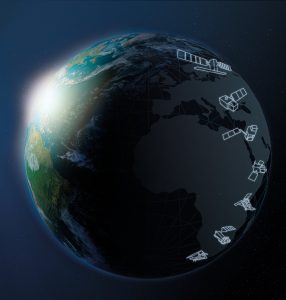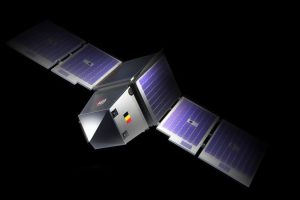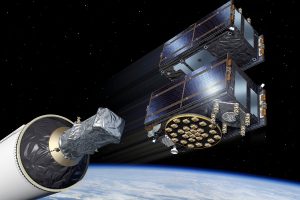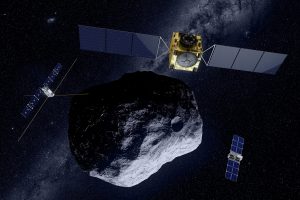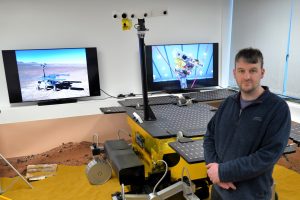The development contracts are worth €2.5 billion, and companies in France, Germany, Italy and Spain will lead work on the various missions – Thales Alenia Space (a Joint Venture between Thales and Leonardo, in France and Italy), Airbus (Germany and Spain) and OHB (Germany).
The UK continues as an ESA Member State despite leaving the EU.
The decision to overlook the well-established UK space industry was met with dismay, reports the BBC.
“The Government has made clear its ambitions for space and is developing a new UK Space Strategy to bring long-term strategic and commercial benefits to the nation,” said a spokesperson for the UK Space Agency.
“While UK organisations will play important roles in five out of the six Copernicus High Priority Candidate missions, we are disappointed overall with the contract proposals and abstained on the vote to approve them. We are committed to working closely with ESA to ensure our investments deliver industrial returns that align with our national ambitions for space.”
It is estimated the value of the sub-contracting for the UK is two-thirds of what had been expected. The UK, however, should play a role in five out of the six Copernicus missions, via organisations including Airbus UK, Thales Alenia Space UK, the National Physical Laboratory, Teledyne, UKRI, Oxford University, Leicester University, IsardSat and M Squared Lasers.
Copernicus programme
These six High Priority Candidate Missions within the Copernicus programme, are intended “to address EU policy and gaps in Copernicus user needs, and to expand the current capabilities of the Copernicus space component” according to ESA.
They are: CHIME: Copernicus Hyperspectral Imaging Mission, CIMR: Copernicus Imaging Microwave Radiometer, CO2M: Copernicus Anthropogenic Carbon Dioxide Monitoring, CRISTAL: Copernicus Polar Ice and Snow Topography Altimeter, LSTM: Copernicus Land Surface Temperature Monitoring, and ROSE-L: L-band Synthetic Aperture Radar.
For example, the CRISTAL mission would involve a multi-frequency radar altimeter and microwave radiometer to measure and monitor sea-ice thickness and overlying snow depth on the planet.
You can read about them here.
“With us concerned about issues such as climate change, Europe’s Copernicus programme and the Sentinel missions play a pivotal role in providing free and open data to manage the environment,” said ESA’s Director General, Jan Wörner.
“These new contracts are the next step in ensuring the family of Copernicus satellites expands to deliver vital information that will ultimately help protect the environment and citizens alike.”
Missions
Thales Alenia Space leads the way with three awards. It will serve as prime contractor for CHIME (Hyperspectral Imaging mission), CIMR (Passive Microwave Imaging Mission) and ROSE L (L-band SAR Mission).
Airbus will lead on LSTM (Land Surface Temperature Monitoring) and CRISTAL (Polar Ice and Snow Topography Altimeter).
OHB System, which is a subsidiary of Bremen-based space and technology group OHB SE, was selected by ESA as the prime contractor for the CO2M mission (Carbon Dioxide Monitoring).
ESA
In terms of its organisational structure, ESA has 22 Member States. They are: Austria, Belgium, the Czech Republic, Denmark, Estonia, Finland, France, Germany, Greece, Hungary, Ireland, Italy, Luxembourg, the Netherlands, Norway, Poland, Portugal, Romania, Spain, Sweden, Switzerland and the United Kingdom. Slovenia is an Associate Member.
ESA has also established formal cooperation with seven Member States of the EU. Canada takes part, too, in some ESA programmes under a Cooperation Agreement.
 The Sentinel 2 satellite is pictured, right. The Sentinels are a fleet of satellites designed to deliver data and imagery to the Copernicus programme. According to the ESA:
The Sentinel 2 satellite is pictured, right. The Sentinels are a fleet of satellites designed to deliver data and imagery to the Copernicus programme. According to the ESA:
Sentinel-2 carries an innovative wide-swath high-resolution multispectral imager with 13 spectral bands for new perspectives of our land and vegetation. The combination of high resolution, novel spectral capabilities, a swath width of 290 km and frequent revisit times will provide unprecedented views of Earth.
Civil Lunar Gateway
At the 290th ESA Council meeting, which made the decision on 24 June, ESA’s 22 Member States also approved “a Memorandum of Understanding with NASA concerning Cooperation on the Civil Lunar Gateway, taking a step towards sending the first European to the Moon”.
Images: ESA
 Electronics Weekly Electronics Design & Components Tech News
Electronics Weekly Electronics Design & Components Tech News
